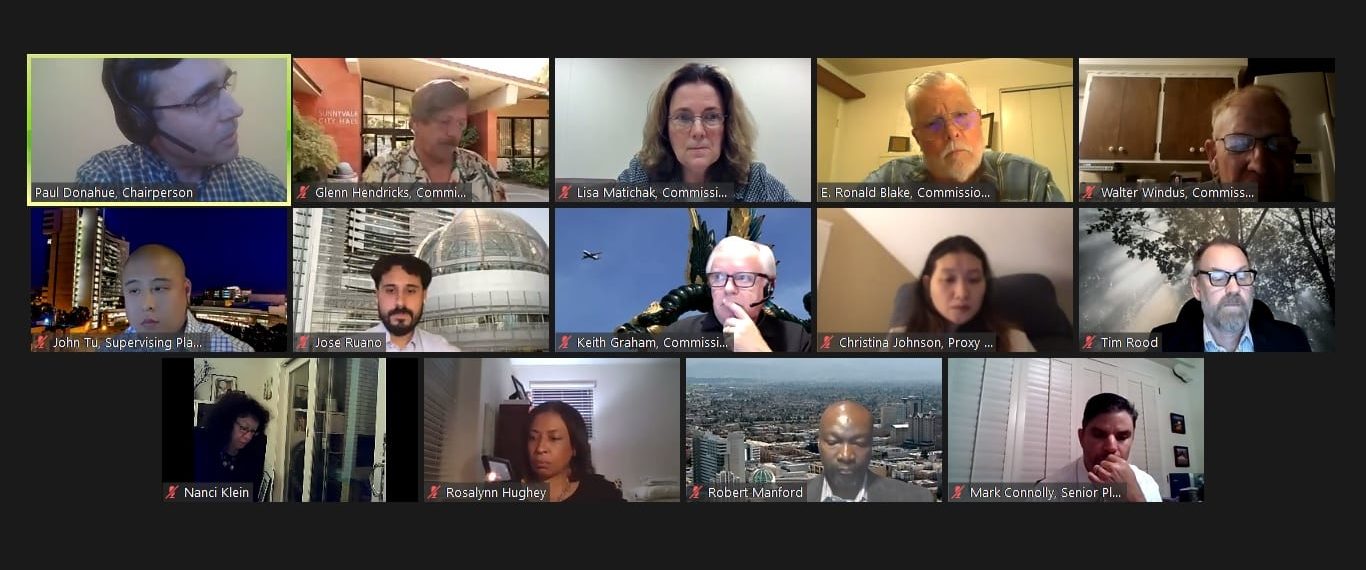A critical airport commission unanimously voted against San Jose’s Diridon plan and Google’s downtown megacampus, taking issue with proposed building heights that would disrupt the city’s international airport.
Santa Clara County Airport Land Use Commissioner Glenn Hendricks admonished San Jose for failing to answer commissioner’s questions.
“I’m extremely disappointed in the city of San Jose Planning Department for having so many people come to this meeting, and the comment was made, ‘We’re just here to listen, we’re not here to answer any questions you have,’” Hendricks said.
San Jose Economic Development Director Nanci Klein, Planning Director Rosalynn Hughey and other city staff attended the Dec. 16 Airport Land Use Commission meeting, which partly focused on the Diridon Station Area Plan (DSAP) and Google’s Downtown West project.

The seven-member commission studies development proposals and land use changes to make sure buildings don’t obstruct airplanes approaching the county’s airports.
Commissioners discussed how the DSAP amendments would impact the Mineta San Jose International Airport, particularly given the increased height limits approved by the San Jose City Council last year.
Mark Connolly, senior planner with the county’s Planning and Development Department, said the height limits of the downtown plans are inconsistent with the airport’s land use policies, referred to as CLUP. The CLUP uses a standard published by Federal Aviation Administration’s regulations on construction near airports.
“We look at three things here at the (Airport Land Use Commission): height, safety and noise,” Hendricks said. “On all three categories that we are charged to review, these changes are not compatible with the CLUP.”
Commissioner Walter Windus asked if the city had considered One Engine Inoperative (OEI) requirements when adopting the new building height limits. An OEI incident occurs when an airplane loses power in one engine during takeoff. Each airline specifies what procedures must be followed in the event of an OEI incident.
Guaranteeing that an airplane would be able to fly past obstacles during an OEI incident may require airlines to reduce the weight of their plane by reducing the number of passengers or limiting the amount of cargo or fuel.
“These ‘weight penalties’ have an economic cost to airlines that could result in a decision to eliminate a flight at SJC, or to not introduce one to this market at all,” reads a fact sheet published by the San Jose airport in 2009.
Commissioner Keith Graham asked the city what happens during construction when a crane is positioned atop a building, requiring it to exceed building height limits.
“The crane discussion is not something we know too much about or can really discuss here tonight,” answered Senior Planner Tong Tu.
Hendricks asked if the city would be able to amend the language in the DSAP to be consistent with the Airport Land Use Commission’s height and safety standards. None of the city staff in attendance definitively answered yes or no.
“I’m not hearing anybody available to answer a question that it was very obvious was going to be asked,” Hendricks said. “If they can’t answer yes, then the obvious answer is no.”
Connolly said Google’s Downtown West proposal is also inconsistent with the airport’s land use standards, violating height and noise limits. Google’s 80-acre plan includes 4,000 housing units, 7.3 million square feet of office space, 10 parks and a 30,000-50,000 square foot community center.
Bhavesh Parikh, Google’s director of real estate development, said he understood the commission’s concerns but the city and community were clear in requesting taller buildings to accommodate more housing and recreational areas.
“Being able to use that height allows us to achieve that vision,” Parikh said.
The commissioners sympathized with Google while maintaining that its plan was inconsistent with the airport’s land use standards. Google had met with Connolly and nearly all commissioners, save for Windus, prior to the meeting.
Commission chair Paul Donahue said the airport’s land use rules are in place to prevent excessive airplane noise and reduce the likelihood that planes will crash into buildings.
“I don’t blame Google at all, they’re following the city’s rules,” Donahue said “But … the city’s rules are inconsistent with ours and misguided.”
Commissioner E. Ronald Blake said the increased height limits would make it difficult for international airlines to safely land planes at the airport.
“If these buildings are built there, it’s just going to convert our international airport back to San Jose Municipal,” Blake said.
Graham said the conflict between the city and the Airport Land Use Commission emerged from city leaders wanting to have the airport close to downtown while still allowing for taller buildings.
“You can’t have it both ways,” Graham said. “You either have a downtown full of skyscrapers 20 miles away… or you have your airport close by with height restrictions.”
In a memo prepared for the meeting, Connolly wrote that if the commission finds the plans inconsistent with airport land use policies, the San Jose City Council or Planning Commission can only overrule their recommendation with a two-thirds vote.
Both the council and Planning Commission would have to notify the Airport Land Use Commission of the plan to overrule 45 days in advance.
The Planning Commission and City Council will hold public hearings on the DSAP and Google’s Downtown West project spring. For more information on both plans, go to the city’s website.
Contact Sonya Herrera at [email protected] or follow @SMHsoftware on Twitter.



Leave a Reply
You must be logged in to post a comment.